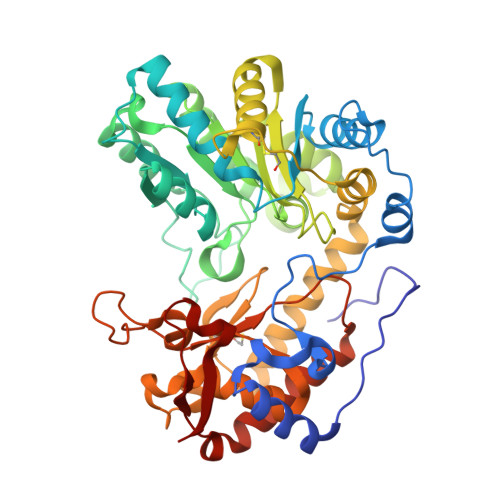Conformational Changes and Loose Packing Promote E. Coli Tryptophanase Cold Lability.
Kogan, A., Gdalevsky, G.Y., Cohen-Luria, R., Goldgur, Y., Phillips, R.S., Parola, A.H., Almog, O.(2009) BMC Struct Biol 9: 65
- PubMed: 19814824
- DOI: https://doi.org/10.1186/1472-6807-9-65
- Primary Citation of Related Structures:
2V0Y, 2V1P - PubMed Abstract:
Oligomeric enzymes can undergo a reversible loss of activity at low temperatures. One such enzyme is tryptophanase (Trpase) from Escherichia coli. Trpase is a pyridoxal phosphate (PLP)-dependent tetrameric enzyme with a Mw of 210 kD. PLP is covalently bound through an enamine bond to Lys270 at the active site. The incubation of holo E. coli Trpases at 2 degrees C for 20 h results in breaking this enamine bond and PLP release, as well as a reversible loss of activity and dissociation into dimers. This sequence of events is termed cold lability and its understanding bears relevance to protein stability and shelf life. We studied the reversible cold lability of E. coli Trpase and its Y74F, C298S and W330F mutants. In contrast to the holo E. coli Trpase all apo forms of Trpase dissociated into dimers already at 25 degrees C and even further upon cooling to 2 degrees C. The crystal structures of the two mutants, Y74F and C298S in their apo form were determined at 1.9A resolution. These apo mutants were found in an open conformation compared to the closed conformation found for P. vulgaris in its holo form. This conformational change is further supported by a high pressure study. We suggest that cold lability of E. coli Trpases is primarily affected by PLP release. The enhanced loss of activity of the three mutants is presumably due to the reduced size of the side chain of the amino acids. This prevents the tight assembly of the active tetramer, making it more susceptible to the cold driven changes in hydrophobic interactions which facilitate PLP release. The hydrophobic interactions along the non catalytic interface overshadow the effect of point mutations and may account for the differences in the dissociation of E. coli Trpase to dimers and P. vulgaris Trpase to monomers.
- Department of Chemistry, Ben-Gurion University of the Negev, Beer-Sheva, Israel. annak@bgu.ac.il <annak@bgu.ac.il>
Organizational Affiliation:



















